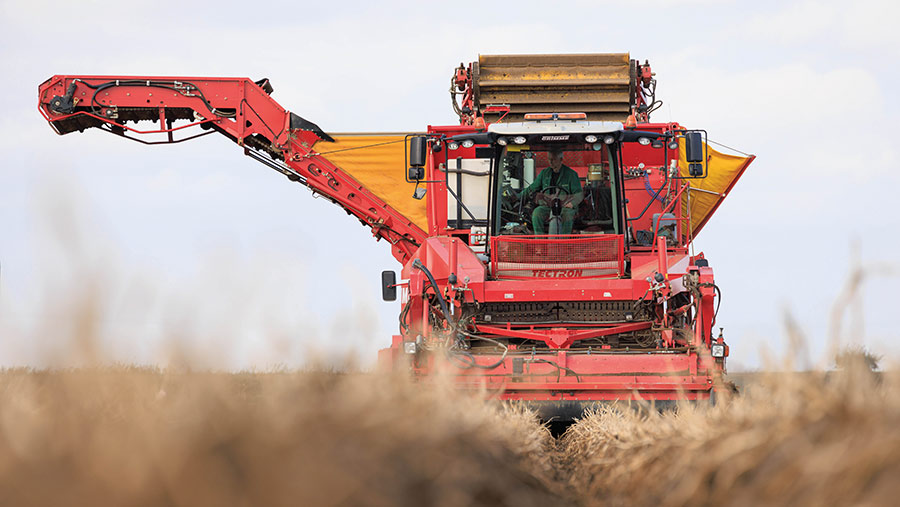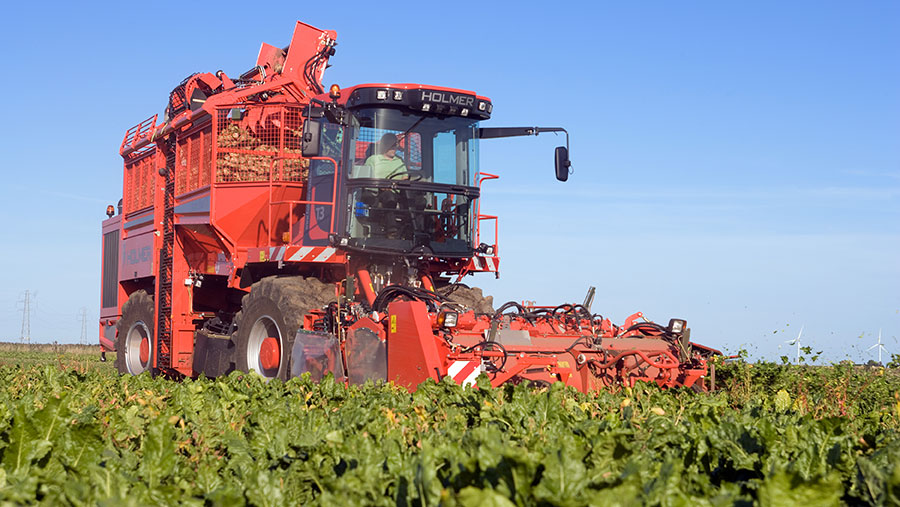Outlook 2023: Potato growers face cost structure challenge
 © Tim Scrivener
© Tim Scrivener Discussions on supply contracts for the 2023 potato crop have commenced early, although at the time of writing, many potato growers are no further forward in reaching agreement.
A reduction in area is both necessary and inevitable, says Andersons director Nick Blake.
A number of growers are choosing to exit, faced with the demand for additional capital to grow the crop, while others are restructuring for a permanent reduction or taking a temporary holiday or short-term reduction.
See also: Potato acreage at risk as cost price squeeze bites deeper
Potato market summary
- Capital burden and soaring costs are delaying 2023 contract negotiations
- Some growers are quitting, others reducing their potato area
- Irrigation application costs now exceed £200/ha in some parts of the country
- Storage costs, including opportunity cost of third-party storage, could now exceed £75/t
Getting the resulting cost structure right is vital. There has always been demand for potato land from third parties, which has helped the numbers add up for those choosing to exit.
However, there may not be so many takers for 2023.
For many growers with irrigated crops, the standout memory of the 2022 season, aside from the overall dramatic increase in costs, was the unrelenting drought and consequent demand on irrigation.
Application commenced early in the season and continued almost without a break. Although this, along with warm, sunny weather, produced some respectable yields, 2022 was a record year for irrigation costs.
Increased electricity and fuel prices and the diverse systems in place widely influenced the actual cost of application.
Taking into account the component costs (labour, energy, reels and booms, pipes, underground infrastructure and licence fees), it now exceeds £200/ha for each application in some parts of the country.
Storage costs are also under the spotlight. It’s not just energy that is driving this; boxes cost between £100-£130 each delivered, and timber and labour is needed to repair them.
In addition, the recent increase in demand for on-farm commercial/industrial storage means potato stores carry a significant opportunity cost.
Recent analysis suggests the equivalent of £20-£25/t could be earned based on a non-farming rental figure of £5/sq ft.
Accounting for boxes, plant maintenance, labour for management and outloading comfortably brings the cost of storing potatoes up to £40/t before energy fees.
Weight loss, sprout control and the cost of capital must also be accounted for. Overall, total storage costs could exceed £75/t for the season.
GB Potatoes, the successor to AHDB Potatoes, is in its infancy.
We have heard of headline aims and the proposed levy rates (growers at £10/ha – significantly less than the AHDB levy), but it is unclear how either will convert into grower benefit.
Sugar beet
Publication of the 2023-24 harvest price as early as July 2022 – with £40/t available, depending on commitment – was a surprise for many growers and a sign of the pressures from high commodity crop prices on all processors, says Andersons director Jamie Mayhew.
A cash advance on a proportion of the 2022-23 crop, along with an increased guaranteed price, gave further confidence to the sector.
Similar to potatoes, the 2023 contract felt like a critical moment for the industry.
There was a good chance that if the price didn’t meet expectations, it would have resulted in a significant reduction in area, supported by buoyant cereal prices.
Attracting growers to return to the crop would have required a further increase.
Sugar beet market summary
- Higher sugar beet prices for 2023-24 will safeguard beet growing on many farms in the short term
- Is the increase a critical moment, or a reprieve?
- Use the higher beet price with caution when budgeting

© Tim Scrivener
The pressure from virus yellows has generally been low in 2022, but it is still a major threat for future seasons.
Drought conditions in eastern England have led to some poor crop development and late start to the harvest – the yield potential from heavier land in drier seasons has to be questioned.
We can only hope for a kinder season in 2023 to help growers maximise the benefits of the higher price.
Overall, while given a reprieve for the moment, the future is still unclear for a crop that has a significant effect on farming in eastern England.
How much difference the new price will make to margins will depend on many factors, not least contractors’ costs, which are rapidly catching up, and the effects of ag inflation, particularly the price of fertiliser.
However, it does look significantly better than it did. The crop always used to deliver a good gross margin every year and hasn’t done so for a while.
That said, it would be a mistake to budget on this sort of price further ahead.
We don’t believe this is a benchmark for the future – British Sugar will pay what it needs to pay to remain competitive in the marketplace.
Some growers, particularly those who are concerned about “hidden” costs from damage to soils and farm tracks, will continue to question the validity of sugar beet, particularly given the value of alternative crops such as wheat.
While they may not be maximising the rotational margin by dropping beet, they could consider they will be better off overall.
